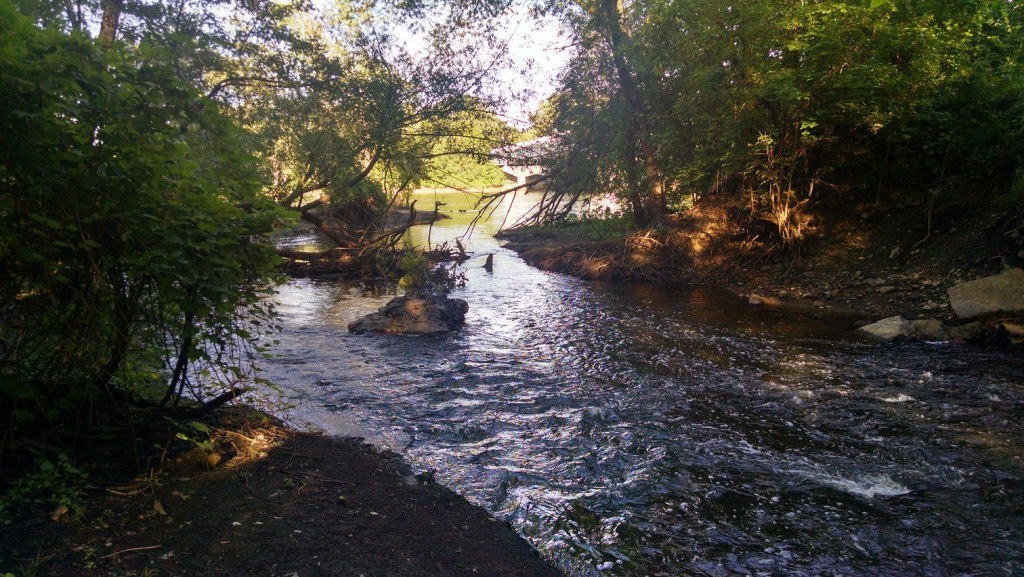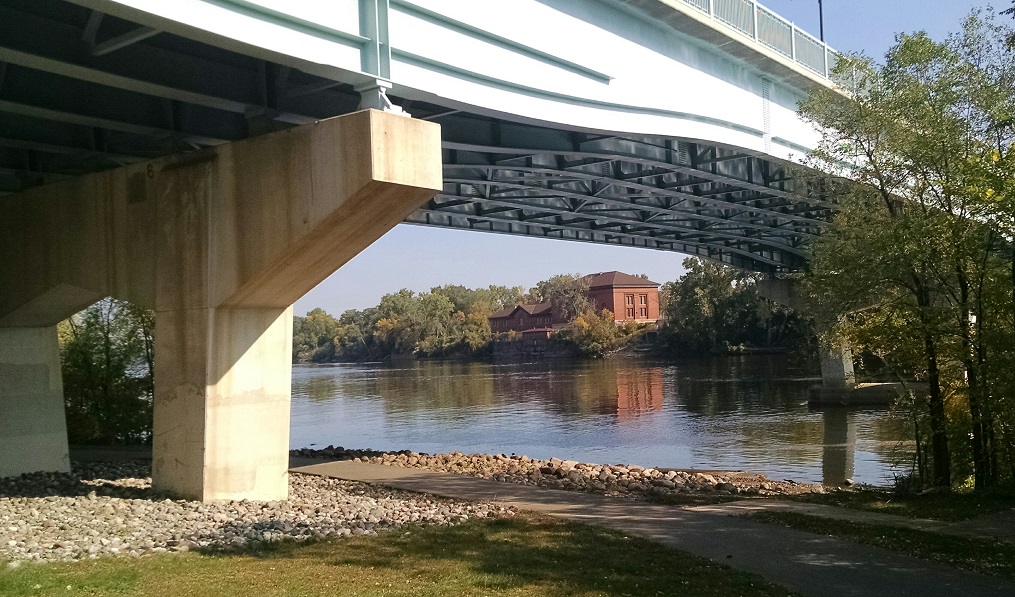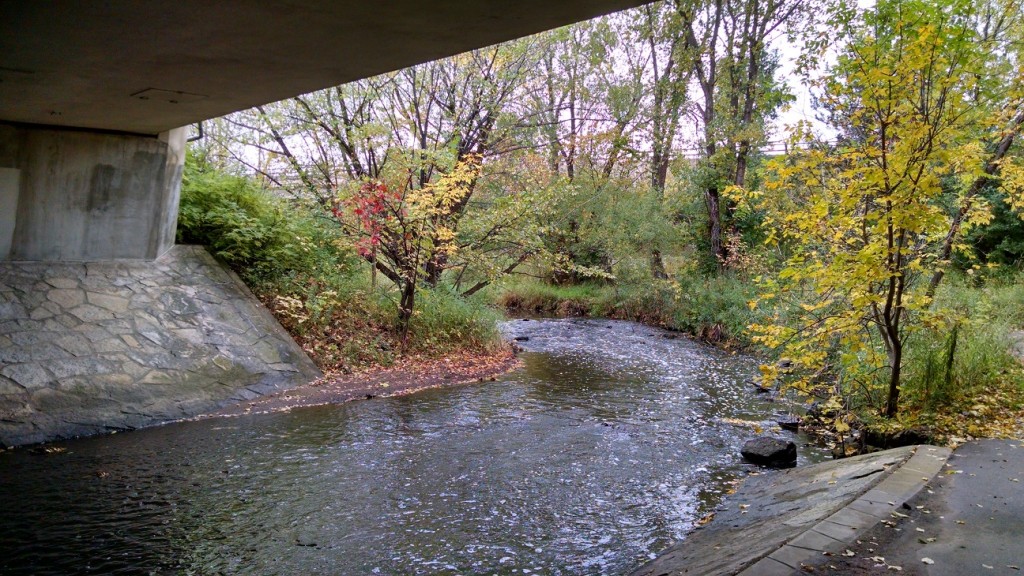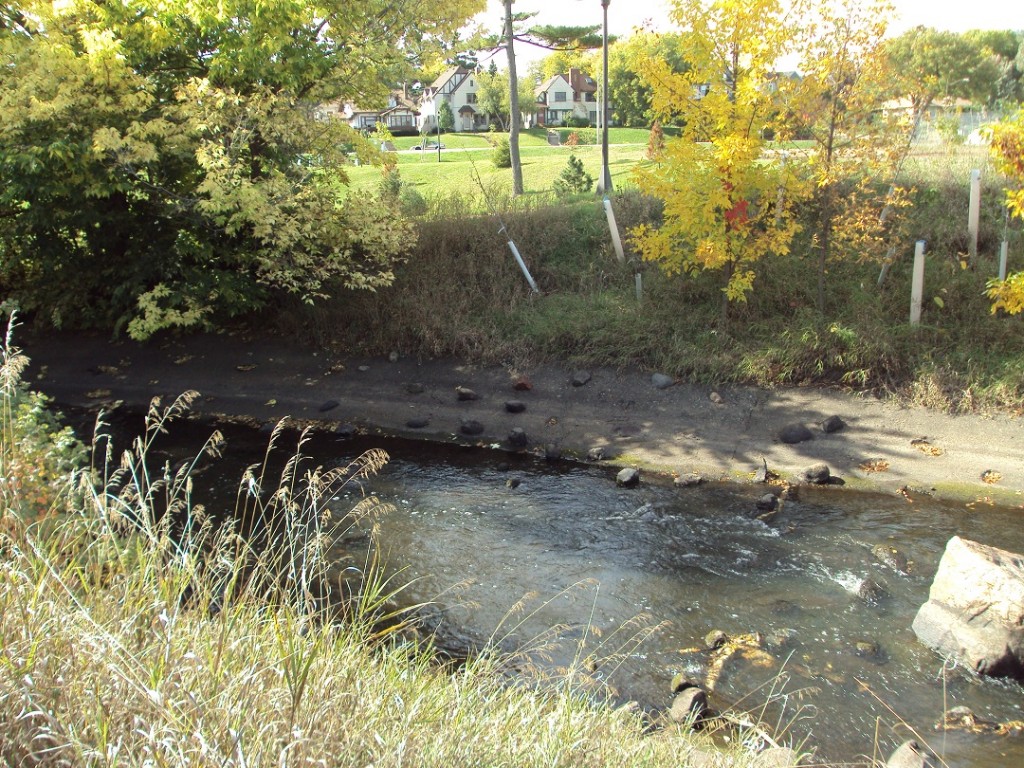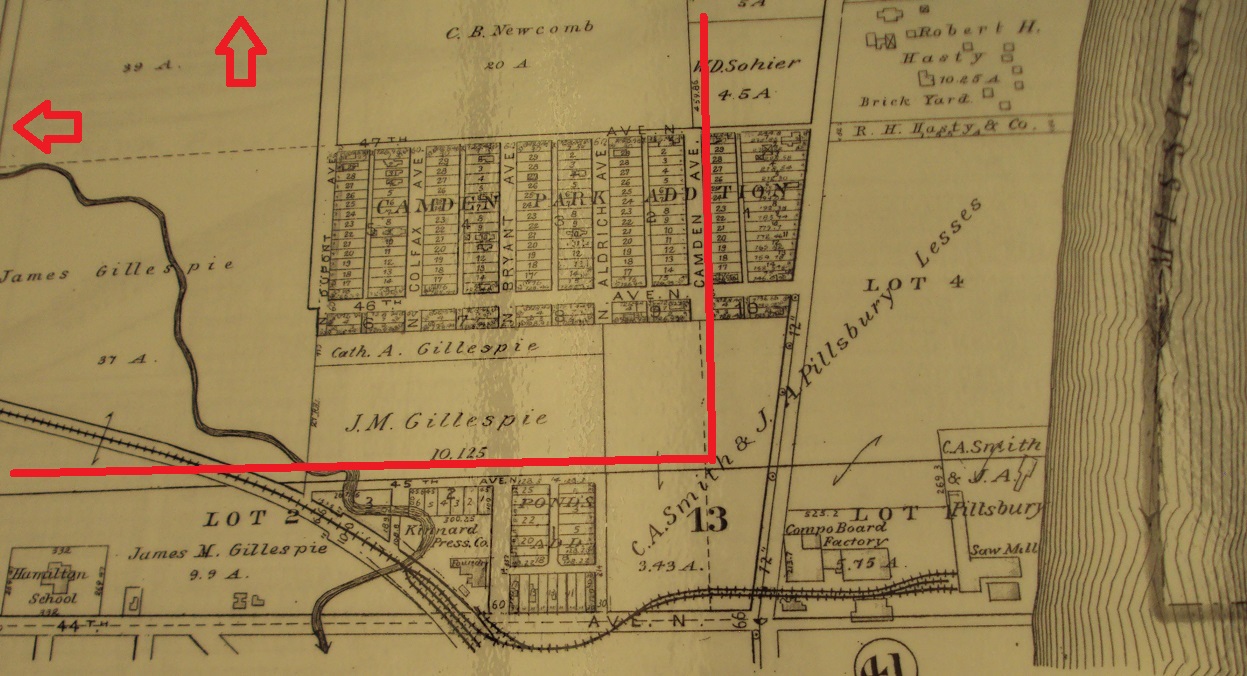Here I am, hooked on another lost golf course, all because I took an afternoon hike.
All because I crossed over Shingle Creek …
… and under the Camden Bridge.
This is North Minneapolis.
“Minneapolis Mystery” was the title of Chapter 29 in my book, “Fore! Gone. Minnesota’s Lost Golf Courses 1897-1999.” It wasn’t set in North Minneapolis but rather a few miles south. The chapter’s crux: trying to unearth the old stomping grounds that was the historic Bryn Mawr Golf Club, 1898-1910. I did it — well, I’m 95 percent certain I did — but it wasn’t easy. Determining the home planets of those who flew the UFOs into Area 51 might have been easier. (For those who want to know more about Bryn Mawr GC, you can A) read my book or B) do the Google and find Minneapolis parks historian David C. Smith’s excellent history of the place.)
Now, presenting Minneapolis Mystery II: Camden Park Golf Club.
In late August, while walking the trails alongside the Mississippi River in North Mississippi Regional Park, I came upon the mouth of Shingle Creek, the point at which it empties into the river. Remembering that I had written about this approximate location in “Fore! Gone.”, with a four-paragraph passage on an almost-unknown course called Camden Park Golf Club, I caught the bug again.
Infernal bug. No known cure. Reafflicted, I decided to try to figure out where Camden Park GC was buried.
NO DENYING IT
Camden Park Golf Club? The North Minneapols locals, even those with deep knowledge of the area’s history, were mostly skeptical. “You know anything about the golf course that used to be around here?” Quizzical, doubting looks. In one or two instances, you’d think I had asked, “You know anything about the Yeti colony that used to be around here?”
Yes, there was a Camden Park Golf Club in North Minneapolis, in the Camden neighborhood and near the intersection of Lyndale Avenue North and what is now Webber Parkway. Almost no one has heard about it because the club was obscure and almost certainly short-lived, with a life span likely short of a decade.
Four documents — the only ones I’ve found that mention Camden Park Golf Course — confirm its existence:
— From the July 21, 1899, Minneapolis Tribune, by way of Smith’s blog: “The Camden Park golf club has been organized among the young men in the employ of the C. A. Smith Lumber company.” The new club, the newspaper reported, had a membership of 25 and growing. “It plays over a beautiful course of nine holes laid out in the Camden park region and crosses the creek three times,” wrote the Tribune. David C. Smith presumed (correctly) that the reference was to Shingle Creek.
— This, from the national 1901 Harper’s Golf Guide: “CAMDEN PARK GOLF CLUB – Post-office address, Camden Place, and sub-station, Minneapolis.”
— An almost-identical entry appears in the 1902 “Official Golf Guide” published by The Grafton Press of New York.
— The golf club is mentioned in a 1905 Minneapolis city directory, with a listed address of “Camden Park Place Athletic Club, 4157 Washn Ave N.”
The Harper’s entry is longer and will be fully transcribed later, but the point is, yes, there was a Camden Park Golf Club.
I had speculated in “Fore! Gone.” that the course might have been within a few hundred yards of the Mississippi River, near the current I-94 corridor and the Camden Bridge.
Mea culpa. Sorta. I think I was wrong. After having spent parts of three months revisiting the subject — walking the area, talking with local residents and experts, Googling up a storm, and viewing old plat maps and city directories — I believe I can say this, firmly and unequivocally, about the site of Camden Park Golf Club:
Damned if I know exactly where it was.
Two theories remain in play for me, the only two that make much sense. A third seems less plausible. Follow along, if you can — the writing is out of necessity quite detailed and probably about as enervating as reading John Milton. If it’s a nugget or two about the golf club and its members you want, just go to the bottom of the post.
Here are the cases stated for each theory, using 42nd Avenue and Lyndale Avenue North as a base point:
TO THE EAST
Theory: Camden Park Golf Club was east of Lyndale Avenue, occupying what is now part of the I-94 corridor and the southern edge of the North Mississippi Regional Park grounds. It covered roughly an area west to east from Lyndale nearly to the Mississippi River and south to north from 42nd (if it had extended east of Lyndale) and 44th (ditto) avenues North.
Likelihood: 10 percent.
Why it could have been: The course was, after all, named Camden Park, and this is the plot that would have been closest to Camden Park — the original Camden Park. A little background: at the time Camden Park GC was organized, Camden Park was east of Lyndale Avenue and 42nd Avenue North, not far from the Mississippi River. A new Camden Park was established in 1908, west of Lyndale and north of what was then referred to as Washington Avenue or Crystal Lake Road. That park now goes by the name Webber Park, so renamed in 1939.
The reference in the Harper’s Guide to “sub-station” as part of the location could have been to the Shingle Creek Pumping Station, which essentially abutted the river on ground that now is a parking lot and launch area at the southern terminus of North Mississippi Regional Park.
Also, considering that the course was organized and/or played by employees of the C.A. Smith company, whose massive lumber mill was based at 4400 Lyndale Avenue North, it’s possible the golfing enthusiasts used part of the lumber mill land for their fledgling course.
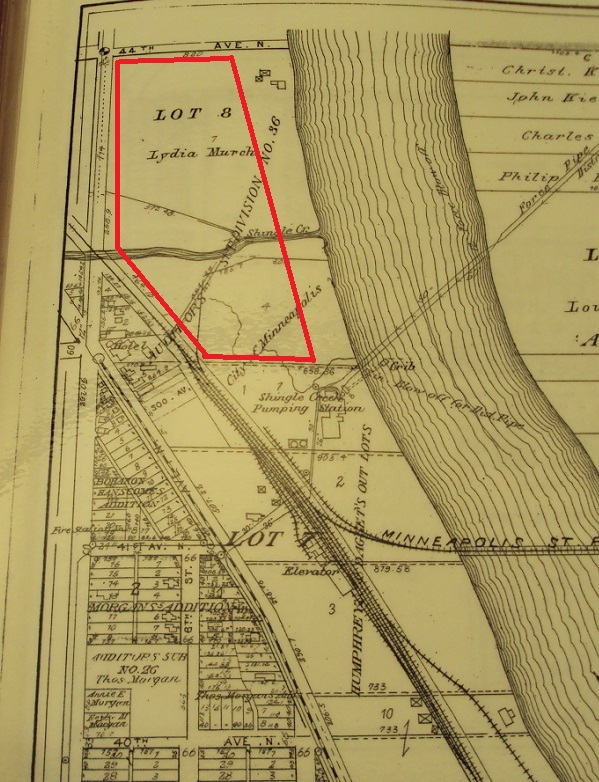
1898 plat map of the area immediately east of 42nd, Lyndale and Washington avenues. Red lines indicate possible approximate borders of Camden Golf Club grounds. (All plat map images used with permission of Hennepin County Library; click on the photos for larger images.)
Why it probably wasn’t: Not enough room. On this plot, the place would have been nicknamed Claustrophobia Country Club. Though the Camden Park course was short by today’s standards, totaling 1,586 yards and with a longest hole of 235 yards, there almost certainly would have been too much neighborly interference to have accommodated even nine short holes here. No room to the west — the Lyndale Hotel (built in 1988, razed in 1912, standing at what is now the foot of the Camden Bridge) was part of a series of buildings and businesses along 42nd, Washington and Lyndale. The course couldn’t have gone far to the southeast because the pumping station was there. Slightly farther south, railroad tracks went as much as four-wide. The course couldn’t have extended farther north than 44th Avenue North because Smith lumber-mill structures were there. Three Shingle Creek crossings in that area is plausible based on the 1898 map, but by 1903 (see map below), Shingle Creek had been moved south and a pond had emerged, with two narrow creek channels leading from it and emptying into the Mississippi River. Most of all, the original Camden Park would have occupied a good share of the golf grounds, and park visitors likely wouldn’t have taken kindly to getting knocked in the noggin by rogue park interlopers playing some newfangled stick-and-ball game.
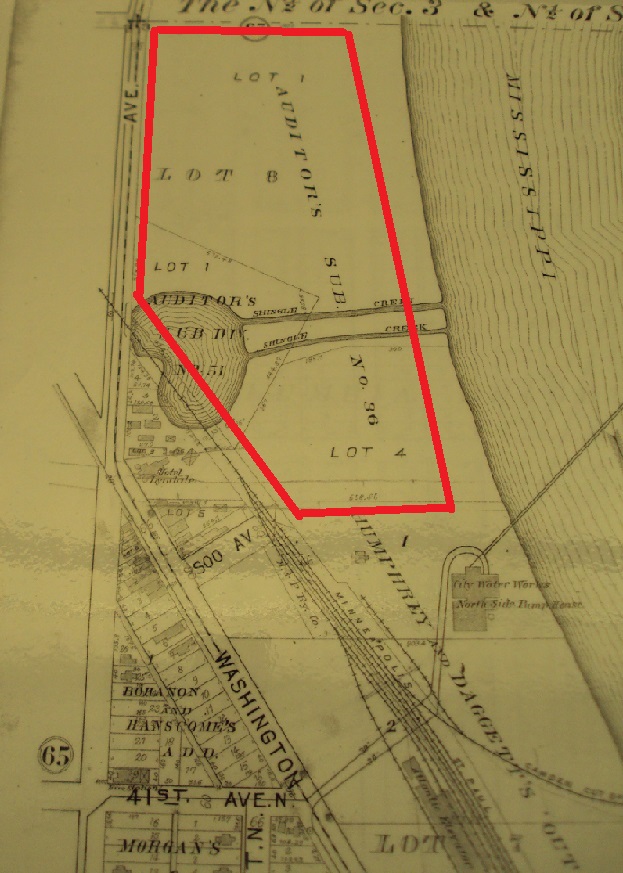
- Beneath the I-94 bridge that crosses over Shingle Creek. This is not the creek’s original path; it used to be farther to the south. This would be close to the grounds of Camden Park Golf Club, if (unlikely) it was east of Lyndale Avenue.
TO THE WEST
Theory: The Camden Park Golf Club grounds occupied an area that is now mostly the eastern edge of Webber Park. Golf-course borders would have been just north of what is now Webber Parkway, extending possibly as far north as 44th Avenue North, and possibly almost as far west as Dupont Avenue, if Dupont had extended north of Webber Parkway. To put it in 2014 terms, think of the area around the Shingle Creek spillway, the Bridge of Dreams and where the Webber Park swimming pool is being built, and you have the likely resting grounds of Camden Park Golf Course.
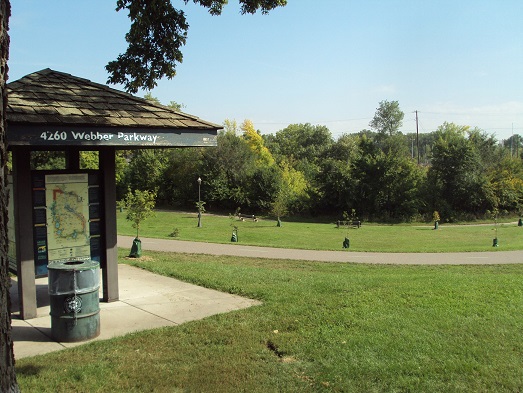
Likelihood: 80 percent.
Why it could have been: Many reasons. 1) Three Shingle Creek crossings would have been eminently feasible (incidentally, Shingle Creek in 1900 nearly abutted what is now Webber Parkway; it has since been re-routed about 100 yards to the north, up against the railroad tracks). 2) The “sub-station” reference can be explained by the likelihood that it was to the nearby post office outlet and not the pumping house. 3) The area would have been larger than the relative broom closet east of Lyndale, especially if land north of the railroad tracks, now occupied by Republic Services, is included. Plat maps confirm this as a larger plot, big enough to accommodate a small golf course, and show no more than a half-dozen structures in the area in 1898. The golf course couldn’t have been south of Washington Avenue, at least not more than a few dozen feet south, because there were homes all along the avenue.
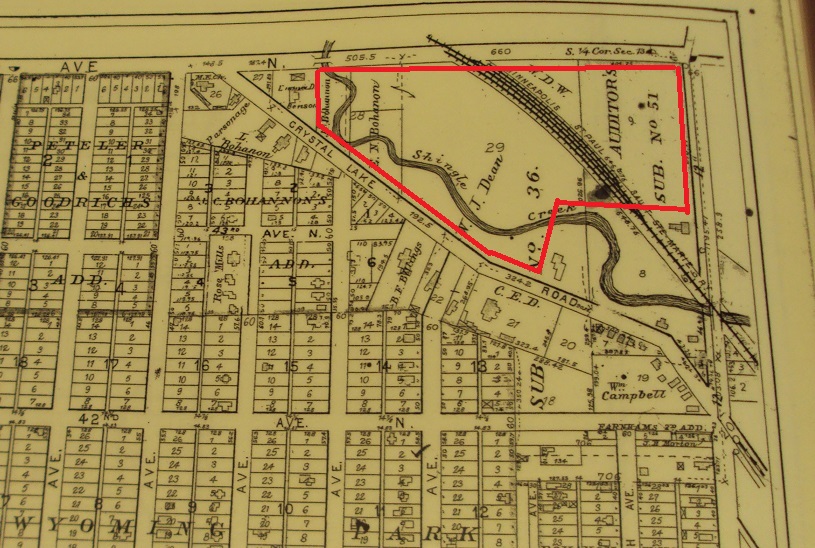
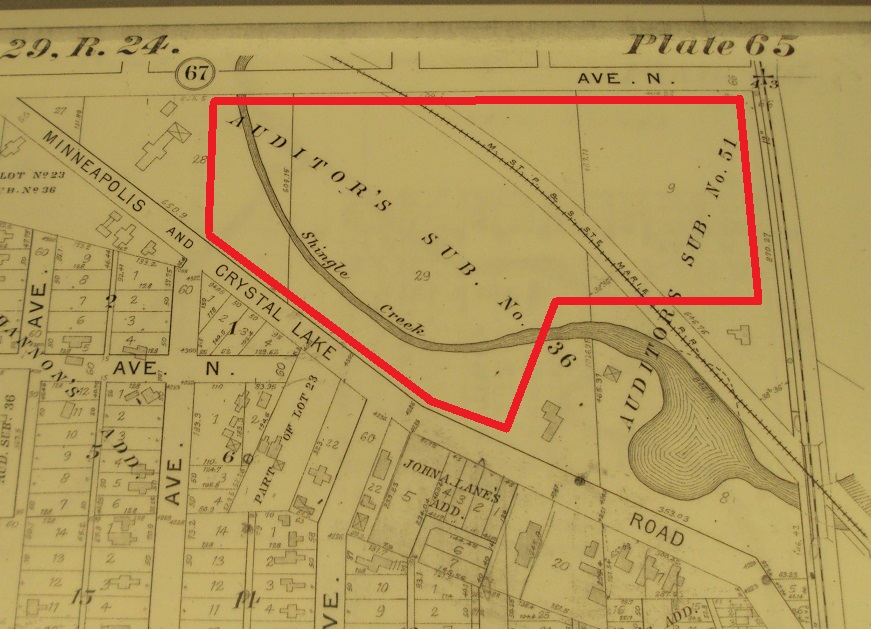
The same area in 1903.
Camden golfers might have been afforded a nearby check-in station at this site — call it a clubhouse if you wish. The 1901 Harper’s Guide lists club officers, including “Chairman of House Committee, W. H. Trabert, 4247 Washington Avenue, North Minneapolis.” That address, now 4247 Webber Parkway, is directly across the street from the current Webber Park. Trabert lived in the same domicile as one Charles L. Trabert, president of the Camden Park Golf Club and a clerk at the C.A. Smith Lumber Company (1906 Hudson’s Directory of Minneapolis says so). I’m thinking the Traberts might have checked in folks at their house, sent them on their way through the front yard, across Washington Avenue and onto the greensward.
Incidentally, in 1904, according to the Saint Paul Globe newspaper, a W.H. Trabert, a sophomore at the University of Minnesota, was seriously injured duing sophomore-party hijinks and had at least part of his foot amputated. The same W.H. Trabert?
Why it might not have been: No good reason I can think of. But I can’t exclude other grounds as long-shot possibilities, so I’m not going to unequivocally state that the old Camden Park Golf Club grounds is on the site of the current Webber Park. Still, my reasonably educated guess says it is.
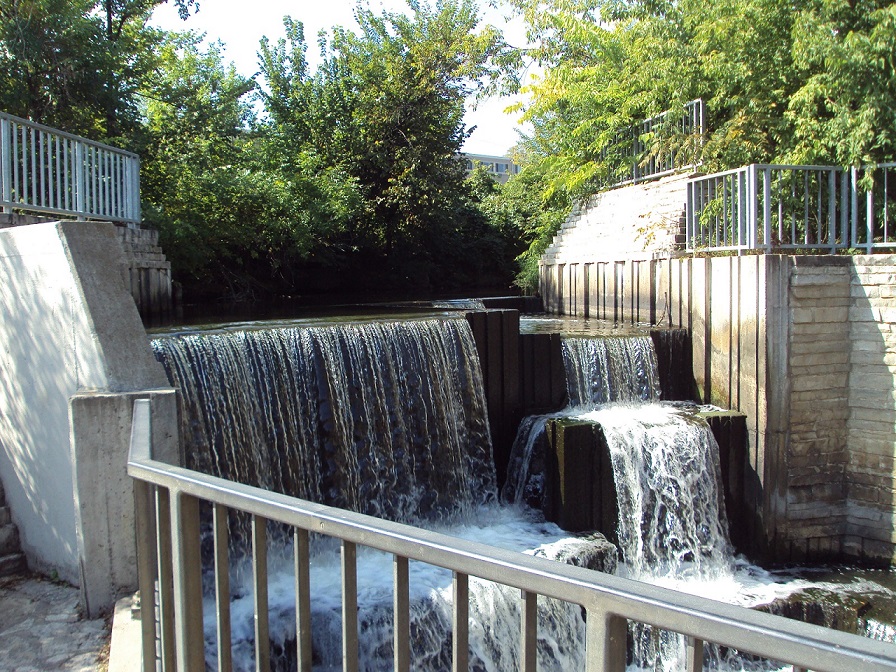
- Shingle Creek, looking south, with Webber Park in the background and homes along Webber Parkway farther back. Though the creek ran farther to the south in 1900, this spot still likely was on the former Camden Park Golf Club grounds.
THEORY 3
I’m leaving open a remote possibility the golf course was in an even larger area north of 44th Avenue North and west of Dupont Avenue — but that site was so far removed from Camden Place and Washington Avenue that it seems unlikely.
Likelihood: 10 percent.
ETC.
— Members of Camden Park Golf Club probably were not the types who pushed and pulled on C.A. Smith’s crosscut saws for 11 hours, then brushed the sawdust off their flannel shirts and walked over for a leisurely (pronounced lezh-er-ly) nine. The club officers were white-collar: Vice president Chester Ellsworth was a lawyer in the Loan & Trust Building, secretary J.O. Wells was a dentist who appears to have boarded with the Traberts on Washington Avenue, and treasurer Carl G. Krook was a lawyer in the New York Life Building (my, that surname was unfortunate).
— Here is full text of the 1901 Harper’s Guide entry, under the heading for Minnesota courses:
CAMDEN PLACE
CAMDEN PARK GOLF CLUB.–Post-office address, Camden Place, and sub-station, Minneapolis. Entrance fee: $15. Annual dues, $1. Membership, 35. A nine-hole course. Distances and bogey figures: 1, 135, 6; 2. 140, 4; 3. 218, 5; 4. 235, 6; 5. 196, 6; 6. 110, 3; 7. 162, 4; 8. 200, 4; 9. 190, 5. President, Charles L. Trabert; Vice-President, Chester Ellsworth; Secretary, Dr. J. O. Wells, Camden Place, Minneapolis; Chairman of House Committee, W. J. Trabert, 4247 Washington Avenue, North Minneapolis; Treasurer, Carl G. Krook. Greenkeeper: Herbert J. Anderson.
— Camden Park GC is not the only lost golf course on Shingle Creek. About 10 miles upstream in Brooklyn Park, near the creek’s northernmost point, Brooklyn Park Golf Course, also known as Joyner’s, hosted golfers from 1962-96 and was bisected by Shingle Creek.
— Heartiest thanks to North Minneapolis folks who lent a hand in my research, including Will Lumpkins and especially including Ron Manger, whose insight into circa-1900 Camden was particularly enlightening. I welcome any corrections, clarifications or further insight.
— Don’t forget to buy my book; you can get it for $19.95 on Amazon.com (buy it through fivestarsales; that’s me). Much of it is a lighter read than this was. I promise.
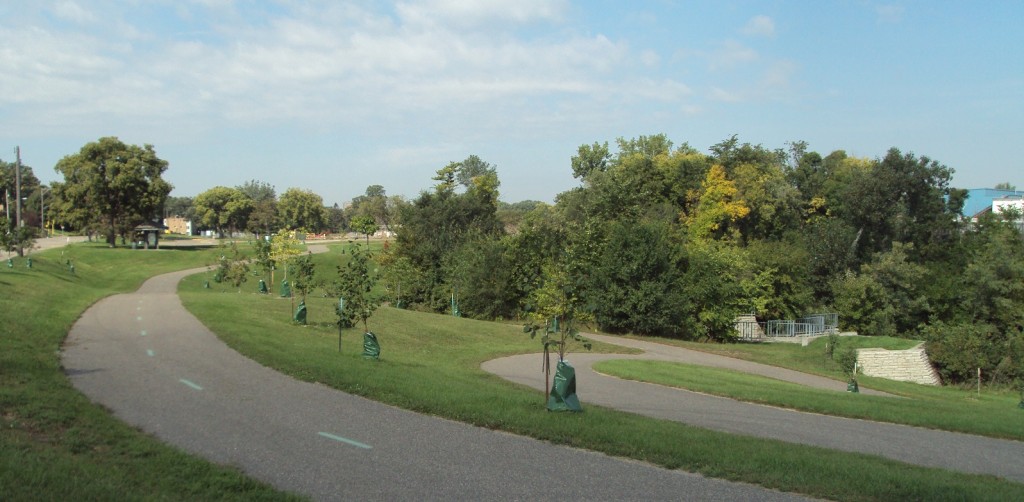
WHAT’S NEXT?
Well, there is this entry in the 1901 Harper’s Guide:
“LAKE HARRIET GOLF CLUB. Organized, 1900. A nine-hole course.”
There it is. Minneapolis Mystery III.
Don’t get me started. Please.
POSTSCRIPT, NOV. 10
I was pleased a couple of weeks ago to receive additional info on Camden Park GC, courtesy of Minnesota golf historian Joe Gladke, who passed along two print clips I hadn’t seen before. They shed no light on the mystery that is the club’s exact resting place, but they do reveal a bit more about the club and golf course.
First, Gladke passed along the Camden Park entry from the 1899 Harper’s Golf Guide. The guide said the club was organized in 1899, listed membership as 25, and listed these folks as officers: President, G.T. Forest; vice-president, Charles L. Trabert; secretary, J.O. Wells; treasurer, John Rogers; advisory board of G.H. Rogers, E.R. King, C.L. Tweed and Miss Nannie Smith.
Also forwarded was a newspaper clip marked July 1899. I’m not positive of the source but suspect it came from the Minneapolis Journal or Minneapolis Tribune. The clip confirms the club’s year of organization as 1899. “The ground is naturally adapted for golf links and the course has been provided with eight sand bunkers, grass, dirt and three times crossing the creek, constituting the hazards.”
The greens, it was reported, were “natural,” which I interpret to mean they were grass greens and not sand. Bogey score was 83. The holes were named Nemo, Ann, Anon, Tacit, Willows, Woods, Creek, Baby, Home. “In another year the club hopes to have acquired enough members to afford a club house,” the clip reported. Mr. Herbert J. Anderson was listed as “official caddie,” and club officers were identical to those listed in the 1899 Harper’s guide except for C.L. Tweed, who was on the advisory board.
